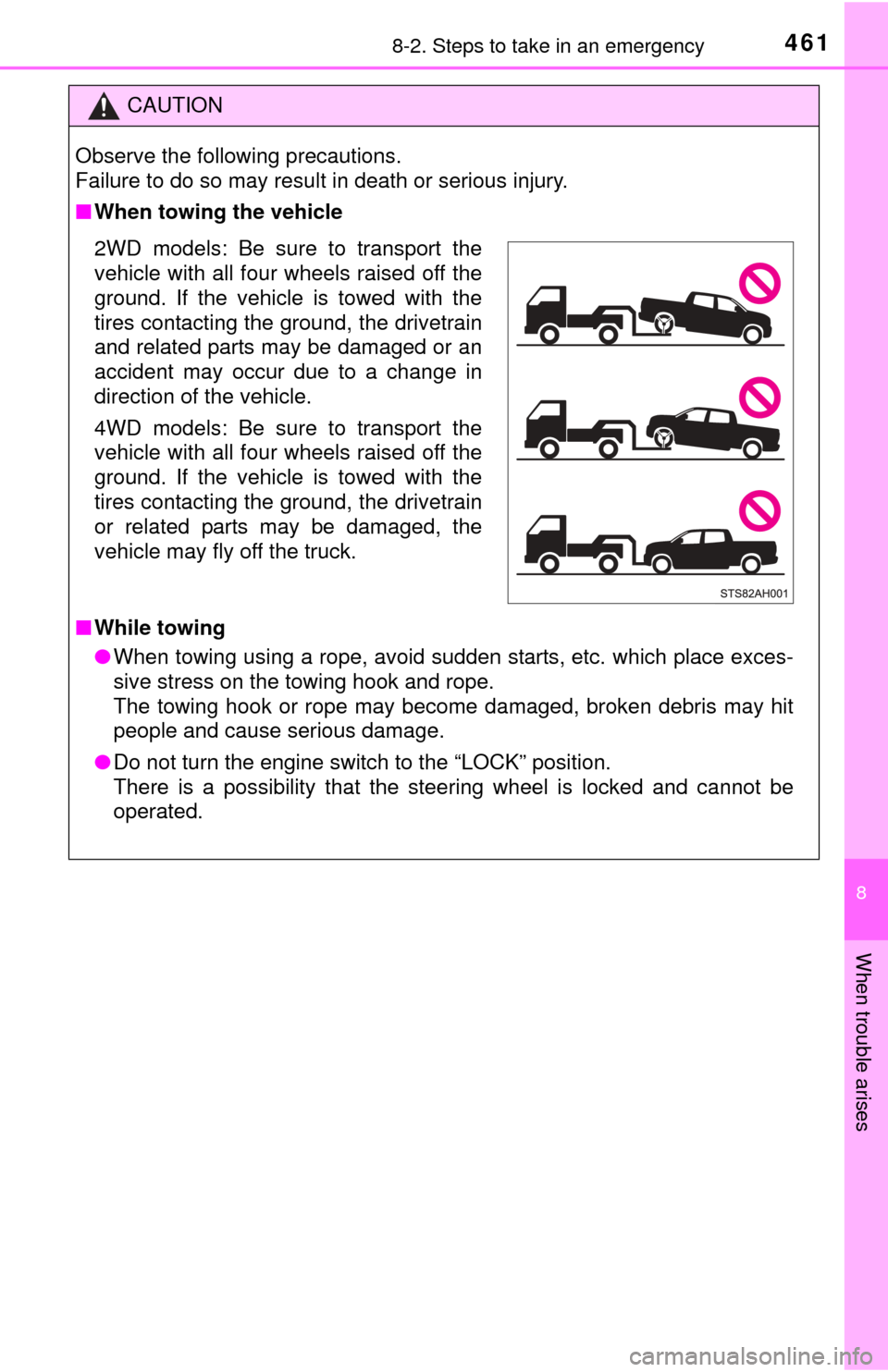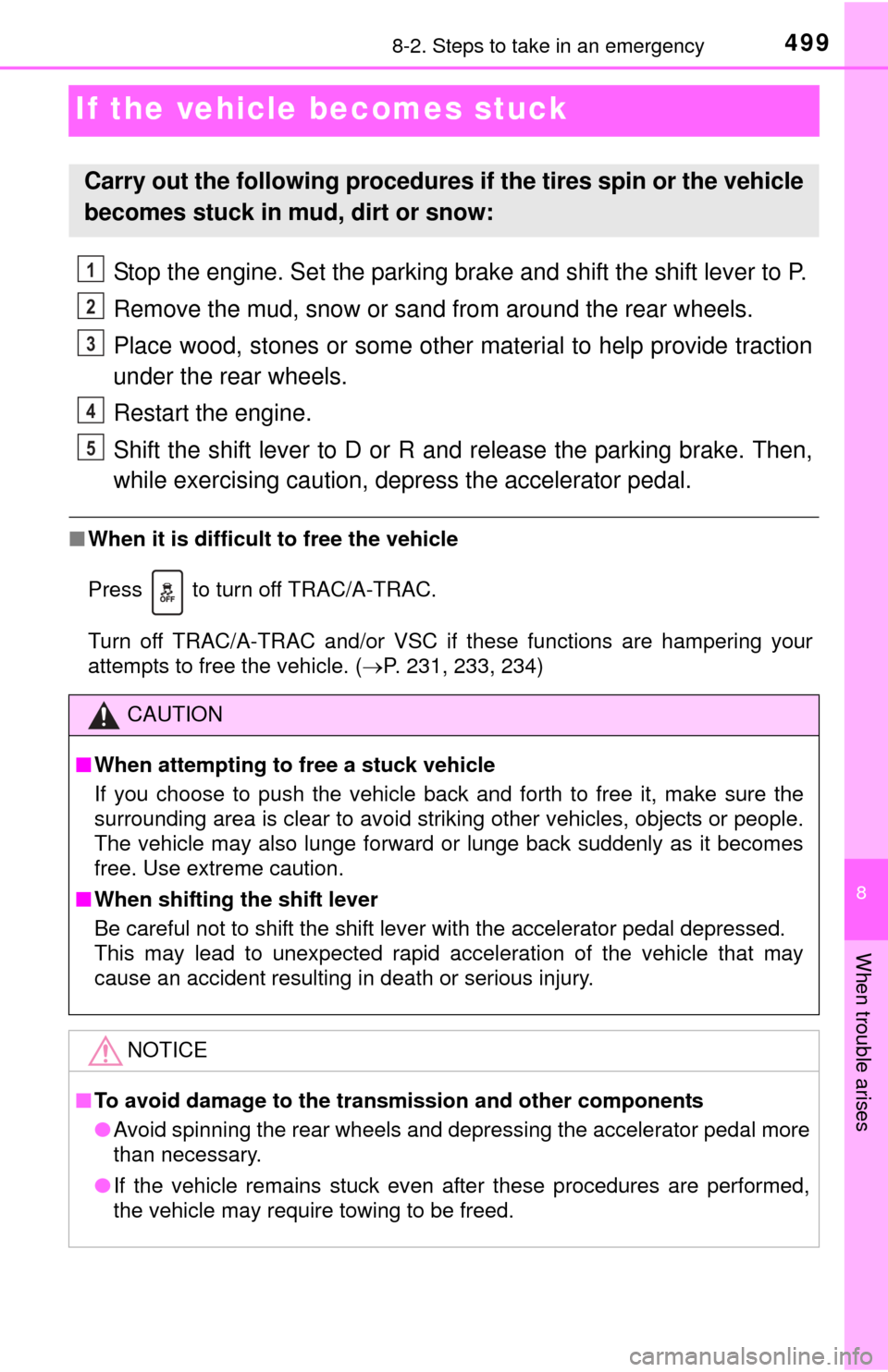Page 460 of 576
4608-2. Steps to take in an emergency
If a tow truck is not available in an emergency, your vehicle may be
temporarily towed using a cable or chain secured to the emergency
towing eyelets. This should only be attempted on hard surfaced roads
for short distances at low speeds.
A driver must be in the vehicle to steer and operate the brakes. The
vehicle’s wheels, drive train, axles, steering and brakes must be in
good condition.
Securely attach a cable or chain to the towing eyelet.
Take care not to damage the vehicle body.
Enter the vehicle being towed and start the engine.
If the engine does not start, turn the engine switch to the “ON” position.
4WD models: Put the front-wheel drive control switch in “2WD”.
Shift the shift lever to N and release the parking brake.
When the shift lever cannot be shifted: ( P. 492)
Emergency towing
Emergency towing procedure
1
2
3
4
Page 461 of 576

4618-2. Steps to take in an emergency
8
When trouble arises
CAUTION
Observe the following precautions.
Failure to do so may result in death or serious injury.
■When towing the vehicle
2WD models: Be sure to transport the
vehicle with all four wheels raised off the
ground. If the vehicle is towed with the
tires contacting the ground, the drivetrain
and related parts may be damaged or an
accident may occur due to a change in
direction of the vehicle.
4WD models: Be sure to transport the
vehicle with all four wheels raised off the
ground. If the vehicle is towed with the
tires contacting the ground, the drivetrain
or related parts may be damaged, the
vehicle may fly off the truck.
■ While towing
● When towing using a rope, avoid sudden starts, etc. which place exces-
sive stress on the towing hook and rope.
The towing hook or rope may become damaged, broken debris may hit
people and cause serious damage.
● Do not turn the engine switch to the “LOCK” position.
There is a possibility that the steering wheel is locked and cannot be
operated.
Page 462 of 576
4628-2. Steps to take in an emergency
NOTICE
■To prevent damage to the vehicle when towing using a wheel-lift type
truck
● Do not tow the vehicle from the rear when the engine switch is in the
“LOCK” position or the key is removed.
The steering lock mechanism is not strong enough to hold the front wheels
straight.
● 2WD models: When raising the vehicle from the rear, ensure adequate
ground clearance for towing at the opposite end of the raised vehicle.
Without adequate clearance, the vehicle could be damaged while being
towed from the rear.
● 4WD models: When raising the vehicle, ensure adequate ground clear-
ance for towing at the opposite end of the raised vehicle. Without ade-
quate clearance, the vehicle could be damaged while being towed.
Page 487 of 576
4878-2. Steps to take in an emergency
8
When trouble arises
Vehicles with aluminum wheels: Remove the center wheel orna-
ment by pushing from the reverse side.
Lay down the tire with the valve
stem facing up and install the
holding bracket centered in the
wheel opening. Turn the jack
handle extension clockwise to
take up slack in the cable.
Check to ensure the holding
bracket is centered in the wheel
opening.
While raising, secu re the tire, tak-
ing care that the tire goes straight
up without catching on any sur-
rounding part to prevent it from
flying forward during a collision or
sudden braking.
CAUTION
■Stowing the flat tire
Failure to follow steps listed under st owing the tire may result in damage
to the spare tire carrier and loss of the tire, which could result in serious
injury or death.
Stowing the flat tire, jack and all tools
1
not centered
centered
2
Page 499 of 576

499
8
When trouble arises
8-2. Steps to take in an emergency
If the vehicle becomes stuck
Stop the engine. Set the parking brake and shift the shift lever to P.
Remove the mud, snow or sand from around the rear wheels.
Place wood, stones or some other material to help provide traction
under the rear wheels.
Restart the engine.
Shift the shift lever to D or R and release the parking brake. Then,
while exercising caution, depress the accelerator pedal.
■When it is difficult to free the vehicle
Press to turn off TRAC/A-TRAC.
Turn off TRAC/A-TRAC and/or VSC if these functions are hampering your
attempts to free the vehicle. ( P. 231, 233, 234)
Carry out the following procedures if the tires spin or the vehicle
becomes stuck in mud, dirt or snow:
CAUTION
■When attempting to free a stuck vehicle
If you choose to push the vehicle back and forth to free it, make sure the
surrounding area is clear to avoid striking other vehicles, objects or people.
The vehicle may also lunge forward or lunge back suddenly as it becomes
free. Use extreme caution.
■ When shifting the shift lever
Be careful not to shift the shift lever with the accelerator pedal depressed.
This may lead to unexpected rapid acceleration of the vehicle that may
cause an accident resulting in death or serious injury.
NOTICE
■To avoid damage to the tran smission and other components
● Avoid spinning the rear wheels and depressing the accelerator pedal more
than necessary.
● If the vehicle remains stuck even after these procedures are performed,
the vehicle may require towing to be freed.
1
2
3
4
5
Page 504 of 576
5049-1. Specifications
Regular Cab models
*1: The model code is indicated on the Certification Label. (P. 510)
*2: Vehicles with towing package
*3: Vehicles with towing package and large fuel tank
*4: Vehicles without option
Vehicle capacity weight
Model code*1EngineDriving
systemBed type
Vehicle capacity weight
(Occupants + luggage)
USK51L-THTSKA 3UR-FE engine 2WD
Long
1965 lb. (890 kg)
1890 lb. (855 kg)*2
1770 lb. (800 kg)*3
2035 lb. (920 kg)*4
USK56L-THTSKA 4WD
1905 lb. (860 kg)
1830 lb. (830 kg)*2
1710 lb. (775 kg)*3
USK56L-THTSGA3UR-FBE
engine 4WD
1905 lb. (860 kg)
1830 lb. (830 kg)*2
1710 lb. (775 kg)*3
Page 506 of 576
5069-1. Specifications
*1: The model code is indicated on the Certification Label. (P. 510)
*2: Vehicles with towing package
*3: Vehicles with towing package and large fuel tank
Model code*1EngineDriving
systemBed type
Vehicle capacity
weight
(Occupants + luggage)
USK56L-CRTSGA
3UR-FBE engine 4WDStandard
1495 lb. (675 kg)
1425 lb. (645 kg)*2
1300 lb. (585 kg)*3
USK56L-CRTLGA
1490 lb. (675 kg)
1415 lb. (640 kg)*2
1295 lb. (585 kg)*3
USK57L-CHTSGA
Long
1475 lb. (665 kg)
1405 lb. (635 kg)*2
1280 lb. (580 kg)*3
Page 509 of 576
5099-1. Specifications
9
Vehicle specifications
*1: The model code is indicated on the Certification Label. (P. 510)
*2: Vehicles with electric moon roof
*3: Vehicles with towing package
*4: Vehicles with towing package and large fuel tank
*5: Vehicles with towing package and electric moon roof
*6: Vehicles with towing package, electric moon roof and large fuel tank
USK56L-PSTSGA
3UR-FBE engine 4WD
Short
1435 lb. (650 kg)
1400 lb. (635 kg)*2
1360 lb. (615 kg)*3
1240 lb. (560 kg)*4
1325 lb. (600 kg)*5
1205 lb. (545 kg)*6
USK56L-PSTLGA
1405 lb. (635 kg)
1370 lb. (620 kg)*2
1335 lb. (605 kg)*3
1210 lb. (545 kg)*4
1300 lb. (585 kg)*5
1175 lb. (530 kg)*6
USK56L-PSTZGA
1410 lb. (635 kg)
1375 lb. (620 kg)*2
1335 lb. (605 kg)*3
1215 lb. (550 kg)*4
1300 lb. (585 kg)*5
1180 lb. (535 kg)*6
Model code*1EngineDriving
systemBed type
Vehicle capacity weight
(Occupants + luggage)